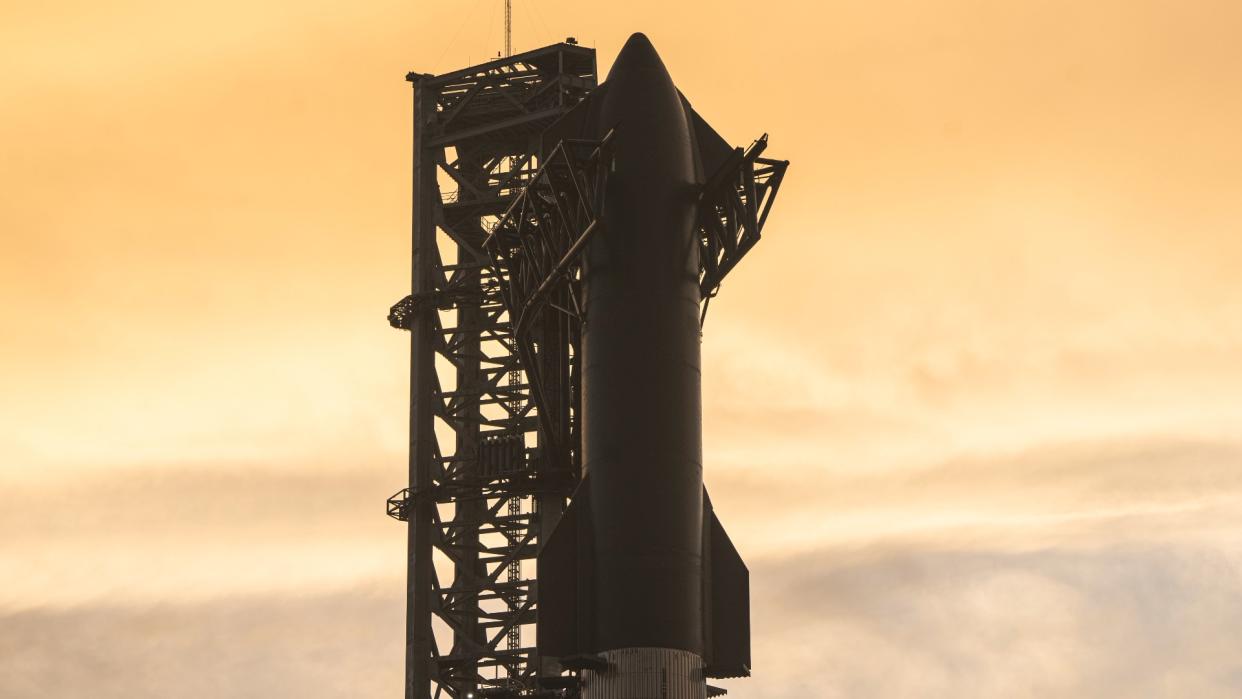SpaceX scrubs 1st space launch of giant Starship rocket due to fueling issue

Update for 7:20 p.m. ET on April 17: On Monday evening (April 17), SpaceX announced it is now targeting Thursday (April 20) for the next Starship space launch attempt. The launch window opens at 9:28 a.m. EDT (1328 GMT) and closes at 10:30 a.m. EDT (1430 GMT).
SOUTH PADRE ISLAND, Texas — We'll all have to wait a little longer to see the most powerful rocket ever built take flight for the first time.
SpaceX had planned to launch a fully stacked Starship vehicle for the first time ever today (April 17), sending the gigantic spacecraft skyward from its Starbase facility here on South Texas' Gulf Coast.
That didn't happen, however. With just under 9 minutes to go in the countdown, SpaceX announced an issue with the pressurization system on Starship's first stage. Mission controllers then decided to transition today's flight test to a wet dress rehearsal, allowing them to work through the vehicle's pre-flight procedures and learn more about the rocket and its systems.
"The point of the countdown is to allow the teams to progress that T-zero time in a coordinated fashion and really to unveil any issues prior to the ignition sequence. So the countdown did its job today," said SpaceX's Kate Tice during today's launch coverage.
Space X will now wait a minimum of 48 hours before attempting another launch. A new launch time has yet to be announced.
Related: Starship and Super Heavy: SpaceX's deep-space transportation for the moon and Mars

Prior to the announcement that today's attempt would be scrubbed, SpaceX founder and CEO Elon Musk stated via Twitter during the countdown that a "pressurant valve appears to be frozen, so unless it starts operating soon, no launch today."
A pressurant valve appears to be frozen, so unless it starts operating soon, no launch todayApril 17, 2023
SpaceX is developing Starship to take people and cargo to the moon and Mars, and to take over pretty much all of the company's spaceflight portfolio down the road.
The deep-space transportation system consists of a huge first-stage booster called Super Heavy and an upper-stage spacecraft known as Starship. When stacked, the vehicle stands 394 feet (120 meters) tall — higher than any other rocket ever built.
Starship will also be the most powerful rocket in history when it takes flight. Its 33 first-stage Raptor engines will generate 16.5 million pounds of thrust at liftoff, nearly twice as much as the current record holder, NASA's Space Launch System megarocket.
Related stories:
— Starship and Super Heavy: SpaceX's Mars-colonizing transportation system
— Elon Musk says SpaceX could launch a Starship to the moon 'probably sooner' than 2024: report
— SpaceX's 1st orbital Starship looks supercool in these fueling test photos
Both of Starship's stages are powered by SpaceX's next-gen Raptor — the upper stage sports six of the engines — and both are designed to be fully and rapidly reusable.
That's the key breakthrough that SpaceX founder and CEO Elon Musk thinks is needed to make the settlement of Mars economically feasible. And Starship shows other hallmarks of a Mars-focused design. For example, its Raptor engines burn liquid oxygen and liquid methane, both of which can be produced on the Red Planet.
Starship won't be going nearly that far on its first space launch, of course. The plan is to bring Super Heavy down in the Gulf of Mexico about eight minutes after launch and send Starship partway around Earth, with a splashdown in the Pacific Ocean near Hawaii.
Mike Wall is the author of "Out There" (Grand Central Publishing, 2018; illustrated by Karl Tate), a book about the search for alien life. Follow him on Twitter @michaeldwall. Follow us on Twitter @Spacedotcom or Facebook.

